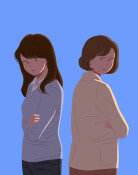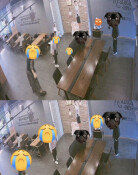Yue Minjun exhibition held in Seoul Arts Center
Yue Minjun exhibition held in Seoul Arts Center
Posted December. 04, 2020 07:43,
Updated December. 04, 2020 07:43

The Seoul Arts Center is holding an exhibition called “Yue Minjun, A-Maze-ing Laughter of Our Times!”. The Chinese artist is known for his works featuring a man laughing ear-to-ear. His laughter symbolizes cynicism about China’s modern history characterized by the fall of the Eastern bloc and the 1989 Tiananmen Square protests. Yue Minjun’s masterpiece “Execution” was at the highest bidding price in 2007, and Sotheby’s described his painting as the most historically valuable work in China’s history of avant-garde art, which is inspired by the Tiananmen Square protests.
The Seoul Arts Center’s exhibition offers some 40 pieces of Yue Minjun’s paintings and sculptures. Though “Execution” in the exhibition is a copied version, the exhibition boasts a range of massive paintings collections from the early 2000s and his recent works. Collections include the “Rolling on the Grass” (2009) and “Lovers” (2012), known for the depiction of a couple with skeleton faces, and one of the exhibition rooms is dedicated to a series of sculptures themed around “laugher is no laughter.”
His recent works show a pronounced tendency for pop arts rather than political connotations. Popular characters such as Batman and Doraemon have been directly borrowed for his paintings. The exhibition could serve as an opportunity for the audience to see how Yue’s works, which were once categorized as “political pop art,” could be applied beyond the realm of politics. Ticket prices are 10,000 to 15,000 won, and the exhibition runs until March 28, 2021.
Busan Museum of Art presets a three-part exhibition for Chinese contemporary arts called “The Scar.” Mainly built around installations and performance arts rather than paintings, the exhibition offers the works of three artists Zhu Jinshi, Song Dong, and Liu Wei. Born in 1954, 1966, and 1972, respectively, the three male artists from China each represent different generations.
Catching the eye is the sheer physical scale of the collections. For instance, Song Dong’s earlier works such as Breathing (1996) or Broken Mirror (1999) were built around the artist’s own performance or props like the mirror. But his latest installation “The Scar” (2020) is a collection of sundries massive enough to block the entrance of the museum lobby. Zhu Jinshi’s paper-based installation art called “South and North” has also been reduced in size to fit the space of the exhibition hall.
Min Kim kimmin@donga.com







